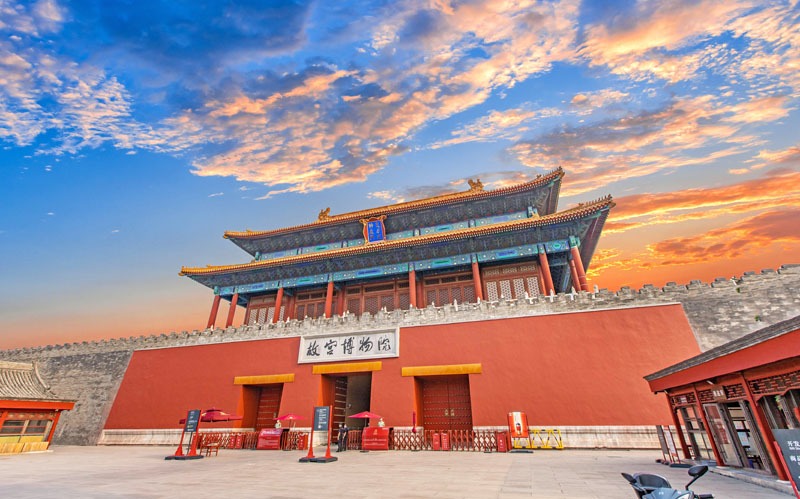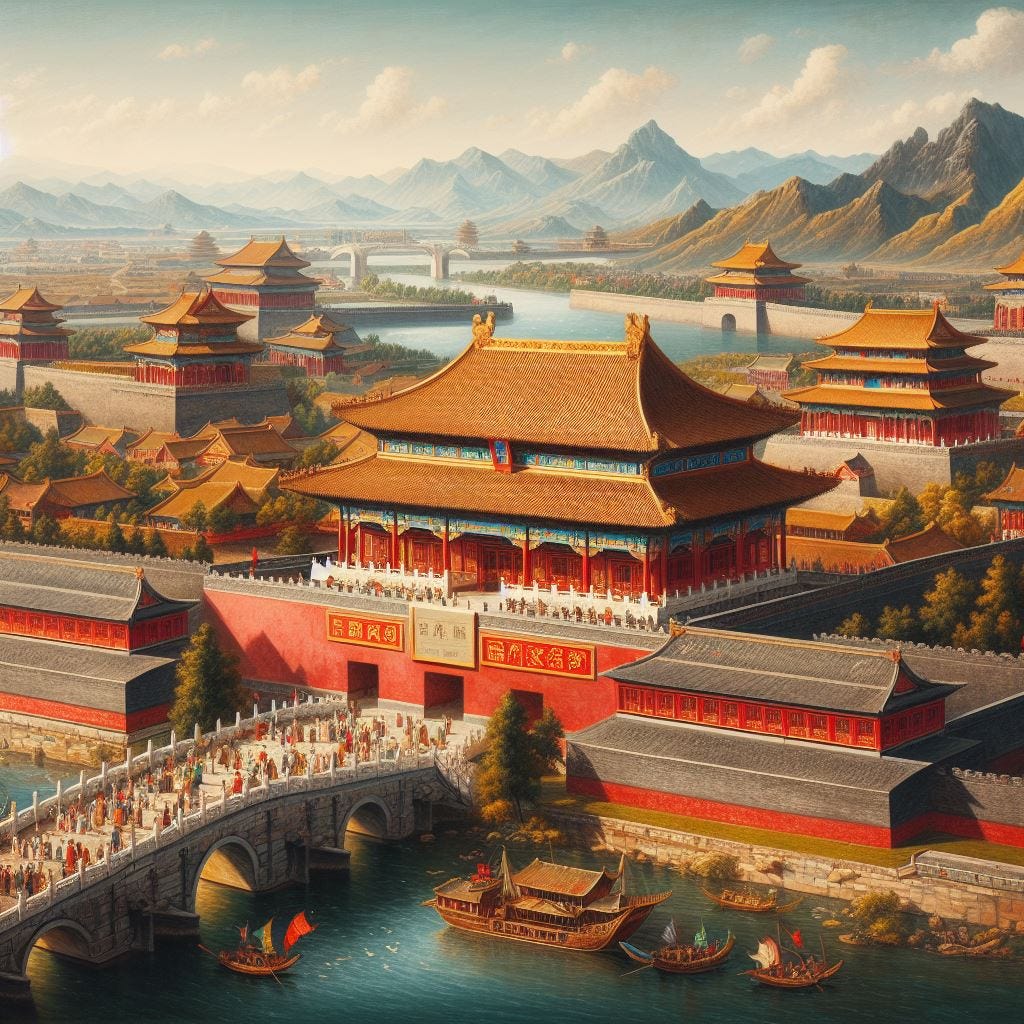Foodie Heaven & Ancient Wonders: Exploring Beijing

Introduction
Beijing is a city that has a lot to offer for food enthusiasts and history buffs. With its rich culinary traditions and ancient wonders, it is a must-visit destination for those who appreciate good food and want to explore the fascinating history of China. From street food stalls to high-end restaurants, Beijing has a wide variety of dining options to satisfy every palate. Additionally, its historical sites, such as the Great Wall and the Forbidden City, make it an ideal place for history lovers to immerse themselves in the country's past.
Overview of Beijing as a destination for food and ancient wonders
Beijing is the capital city of China and serves as a melting pot of different regional cuisines. One can find a wide range of local dishes as well as dishes from other parts of China. The city is known for its Peking Duck, a famous and much-loved delicacy enjoyed by locals and tourists alike. In addition to Peking Duck, there are many other traditional Beijing dishes like Dumplings (Jiaozi), Hot Pot, and Mongolian Hot Pot. These dishes reflect the rich culinary traditions of the region.
Apart from its culinary delights, Beijing is also home to numerous ancient wonders. The Great Wall of China, one of the world's most famous landmarks, is a UNESCO World Heritage site and a must-visit attraction for anyone visiting Beijing. The Forbidden City, another UNESCO World Heritage site, is an enormous palace complex that served as the imperial residence for emperors of the Ming and Qing dynasties. These historical sites offer visitors a glimpse into China's rich history and architectural marvels.
Why Beijing is a must-visit city for food enthusiasts and history buffs
Beijing offers a unique blend of culinary delights and historical sites that make it a must-visit city for food enthusiasts and history buffs. Here are some reasons why:
-
Diverse food options: Beijing's culinary scene is diverse, with a wide range of options to cater to different tastes and preferences. From traditional dishes to international cuisines, there is something for everyone in the city.
-
Rich culinary traditions: Beijing is known for its rich culinary traditions, which have been passed down through generations. Trying authentic Beijing dishes gives visitors a chance to experience the local food culture.
-
Ancient wonders: The historical sites in Beijing, such as the Great Wall and the Forbidden City, offer a glimpse into China's rich history and architectural wonders. Exploring these sites allows history buffs to immerse themselves in the country's past.
-
Cultural experiences: In addition to the food and historical sites, Beijing also offers various cultural experiences, such as traditional Chinese tea ceremonies and calligraphy classes. These activities allow visitors to fully immerse themselves in the local culture.
Beijing is a city that has something for everyone, whether you are a food enthusiast or a history buff. Its diverse culinary scene and ancient wonders make it a must-visit destination for those who want to experience the best of Chinese food and history.
Beijing's Culinary Delights
Famous Beijing dishes to try
Beijing is known for its famous dishes that are loved by locals and tourists alike. Here are some must-try dishes when visiting the city:
- Peking Duck: Peking Duck is a signature dish of Beijing and is often considered one of the best dishes in Chinese cuisine. The duck is roasted to perfection, with crispy skin and tender meat, and is usually served with thin pancakes, scallions, and Hoisin sauce.
- Dumplings (Jiaozi): Dumplings are a staple in Beijing cuisine and come in various fillings such as pork, shrimp, and vegetables. They are typically boiled or steamed and are served with soy sauce or vinegar for dipping.
- Hot Pot: Hot Pot is a popular dining experience in Beijing, where diners cook a variety of raw ingredients in a simmering pot of flavorful broth. The ingredients can include thinly sliced meat, vegetables, tofu, and noodles.
- Mongolian Hot Pot: Similar to Hot Pot, Mongolian Hot Pot is a variation where the broth is spicier and more robust. It is often enjoyed during colder months.
Street food and local markets in Beijing
For a truly authentic culinary experience, exploring the street food stalls and local markets in Beijing is a must. Here are some food spots to check out:
| Location | Specialty |
|---|---|
| Donghuamen Night Market | Fried scorpions, lamb skewers, and deep-fried stinky tofu |
| Wangfujing Snack Street | Candied hawthorn, fried insects, and traditional Beijing snacks |
| Huguosi Street Snack Night Market | Stir-fried liver and intestines, steamed buns, and sesame pancakes |
| Xinmin Street Night Market | Grilled seafood, spicy crayfish, and grilled lamb skewers |
Visiting these street food stalls and local markets allows you to sample a wide variety of traditional Beijing snacks and interact with friendly vendors. It's a great way to immerse yourself in the local food culture and discover unique flavours.

Exploring the Great Wall of China
History and significance of the Great Wall
The Great Wall of China, one of the world's most iconic landmarks, is a must-visit when in Beijing. Built over centuries, this magnificent structure has a rich history and holds great significance for the Chinese people. Here are some facts about the Great Wall:
- Historical Legacy: The construction of the Great Wall began over 2,000 years ago and continued for many dynasties. It was initially built as a defence system to protect the Chinese empire from invasions and raids.
- Length and Structure: The Great Wall stretches over 13,000 miles across mountains, deserts, and grasslands. It is made up of various sections, including the famous Badaling, Mutianyu, and Jinshanling areas.
- Symbol of Unity: The Great Wall is considered a symbol of China's unity and resilience. It represents the determination and strength of the Chinese people throughout history.
- UNESCO World Heritage Site: In 1987, the Great Wall was designated as a UNESCO World Heritage Site, recognizing its outstanding universal value.
Best sections of the Great Wall to visit in Beijing
While the entire Great Wall is awe-inspiring, here are some of the best sections to visit during your trip to Beijing:
| Section | Distance from Beijing | Highlights |
|---|---|---|
| Badaling | Approximately 43 miles | Most well-preserved section, stunning panoramic views, easily accessible |
| Mutianyu | Approximately 42 miles | Less crowded, picturesque scenery, cable car and toboggan rides |
| Jinshanling | Approximately 81 miles | Untouched beauty, great for hiking, watchtowers with different architectural styles |
| Simitai | Approximately 83 miles | Less touristy, challenging hikes, breathtaking views of the surrounding countryside |
Visiting these sections allows you to walk along the ancient walls, soak in the stunning vistas, and immerse yourself in the grandeur of this architectural marvel. Whether you choose a popular section or a more remote one, exploring the Great Wall will undoubtedly be a memorable experience.

The Forbidden City
Introduction to the Forbidden City
When visiting Beijing, another must-see historical site is the Forbidden City. With its impressive architecture and rich history, it offers a glimpse into China's imperial past. Here are some key facts about the Forbidden City:
- Historical Significance: The Forbidden City served as the imperial palace for emperors during the Ming and Qing dynasties. It was the political and ceremonial centre of China for nearly 500 years.
- Architectural Beauty: Spread across 180 acres, the Forbidden City boasts over 900 buildings, including palaces, halls, and gardens. Its intricate design and ornate decorations showcase traditional Chinese architecture.
- UNESCO World Heritage Site: In 1987, the Forbidden City was listed as a UNESCO World Heritage Site, recognizing its cultural and historical importance.
- Cultural Significance: The Forbidden City provides insights into imperial life and rituals, offering visitors a chance to understand China's rich cultural heritage.
Highlights and must-see attractions within the Forbidden City
Exploring the vast complex of the Forbidden City can be overwhelming, so here are some highlights and must-see attractions to help you make the most of your visit:
| Attraction | Description |
|---|---|
| Hall of Supreme Harmony | The largest and most important ceremonial hall in the Forbidden City, featuring fantastic wooden sculptures and imperial thrones. |
| Palace Museum | Home to an extensive collection of imperial treasures, including artefacts, paintings, and calligraphy from various dynasties. |
| Imperial Garden | A serene retreat with beautiful landscapes, pavilions, and ancient trees, providing a tranquil atmosphere amidst the bustling city. |
| Treasures Gallery | A treasure trove displaying precious artefacts, such as jade carvings, intricate porcelain, and ancient bronze objects. |
These attractions offer a glimpse into the opulent lifestyle of China's emperors and the grandeur of their surroundings. As you wander through the Forbidden City, marvel at the intricate details and immerse yourself in this historical treasure.

Wangfujing Street Food Market
A paradise for foodies: Wangfujing Street Food Market
When you're in Beijing and looking for a culinary adventure, make sure to visit the famous Wangfujing Street Food Market. This bustling market is every food lover's dream, offering a wide variety of delicious and exotic street food. Here's why Wangfujing Street Food Market is a must-visit:
- Diverse Culinary Offerings: Wangfujing Street Food Market is a treasure trove of local and international flavours. From traditional Chinese snacks to global cuisines, you'll find an array of mouthwatering options to satisfy your taste buds.
- Vibrant Atmosphere: This food market buzzes with energy and excitement. The lively atmosphere, with its colourful stalls and aromas wafting through the air, adds to the overall experience and makes it a must-visit destination.
- Fresh and Authentic: Wangfujing Street Food Market guarantees freshness and authenticity. Many of the vendors prepare their food right in front of you, using fresh ingredients and traditional cooking methods, ensuring that you get a true taste of Beijing's culinary culture.
- Unique Street Eats: Wangfujing Street Food Market is renowned for its unique street foods that often push the boundaries of adventurous eating. From scorpion skewers to grilled squid, you'll have the opportunity to try something out of the ordinary.
Local delicacies and unique culinary experiences
At Wangfujing Street Food Market, you'll encounter a delightful array of local delicacies that showcase the rich flavours and culinary traditions of Beijing. Here are some must-try dishes and experiences:
| Delicacy | Description |
|---|---|
| Beijing Duck | Indulge in the famous Beijing roast duck, a crispy and savoury delight that has been a culinary tradition for centuries. |
| Stinky Tofu | Brave the strong aroma and savour the uniquely fermented tofu that has become a favourite among locals and adventurous eaters. |
| Chuan'r | Experience the flavours of Beijing street food with Chuan'r, skewered meats and vegetables grilled to perfection and seasoned with aromatic spices. |
| Jianbing | Try the popular Beijing-style crepe, filled with a variety of ingredients such as eggs, crispy fried dough, scallions, and savoury sauces. |
Wangfujing Street Food Market is a culinary heaven that offers a feast for your senses. So, don't miss the opportunity to explore this vibrant market and indulge in the delectable flavours of Beijing street food.
Summer Palace
Overview of the Summer Palace and its history
If you're visiting Beijing, a trip to the Summer Palace is a must. This historic imperial garden is a serene retreat from the bustling city and offers a glimpse into China's rich history. Here's what you need to know about the Summer Palace:
- Historical Significance: The Summer Palace was originally built in the 18th century as a royal retreat for the Qing Dynasty emperors. It served as a palace complex with gardens, pavilions, and temples and has since been recognized as a UNESCO World Heritage Site.
- Architectural Marvel: The architecture of the Summer Palace is a blend of traditional Chinese design and natural elements. The main attraction is the iconic Longevity Hill, which offers stunning panoramic views of Kunming Lake and the surrounding gardens.
- Cultural Importance: The Summer Palace holds great cultural significance in Chinese history. It was a place for the royal family to relax, hold ceremonies, and entertain guests. Today, it serves as a popular tourist destination and symbolizes Chinese architectural and gardening excellence.
Exploring the beautiful gardens and the iconic Long Corridor
One of the highlights of the Summer Palace is its beautiful gardens, which cover over 700 acres. Here, you can stroll through meticulously landscaped pathways, admire the vibrant flowers and plants, and relax by the tranquil Kunming Lake.
The Long Corridor is another must-see attraction within the Summer Palace. Stretching for 728 meters, it is the longest-covered walkway in the world. The corridor is adorned with intricate paintings depicting scenes from Chinese history, mythology, and folklore, making it a feast for the eyes.
Visiting the Summer Palace is not only a chance to immerse yourself in China's history and culture but also an opportunity to unwind and find peace amidst nature. So, don't miss the chance to explore this enchanting destination during your visit to Beijing.

Hutongs of Beijing
Understanding the traditional courtyard houses of Beijing
If you're visiting Beijing, another fascinating part of the city's history and culture that you must explore is the Hutongs. These traditional alleyways lined with courtyard houses offer a glimpse into the old Beijing lifestyle. Here's what you need to know:
- Historical Significance: Hutongs have been an integral part of Beijing since ancient times. They were originally built during the Yuan Dynasty and served as residential areas for commoners. Today, they provide a link to the city's past and are cherished for their architectural and cultural value.
- Unique Architectural Design: The traditional courtyard houses, known as Siheyuan, are the main feature of the Hutongs. These houses typically have a square or rectangular layout, with rooms surrounding a central courtyard. The roofs are often adorned with ornate decorations, symbolizing power and social status.
- Vibrant Community Life: The Hutongs were once bustling with community activities and social interactions. Residents would gather in shared spaces, such as wells or public baths, to catch up and connect. Nowadays, while some Hutongs have been converted into tourist attractions, many still serve as residential areas, giving you a chance to experience the authentic local lifestyle.
Exploring the charming alleyways and unique vibe of Beijing's Hutongs
Walking through the Hutongs is like stepping back in time. The narrow alleyways are filled with hidden treasures, including small shops, local eateries, and traditional courtyard houses. Here's what you can expect during your exploration:
- Local Delights: The Hutongs are a food lover's paradise, offering a wide range of local specialities. From Beijing's famous Peking duck to steamed buns and street snacks, you'll have plenty of delicious options to satisfy your taste buds.
- Unique Atmosphere: The Hutongs have a distinct ambience that sets them apart from the modern cityscape. The slow-paced lifestyle, the sound of bicycle bells, and the sight of elderly residents playing traditional games add to the charm and authenticity of these historic neighbourhoods.
- Insight into Local Crafts and Art: Many Hutongs are home to talented artisans who have preserved ancient crafts and traditional art forms. You can visit workshops and studios to learn about practices like calligraphy, paper cutting, or porcelain making, and even try your hand at these crafts.
Taking a stroll through the Hutongs will not only give you a deeper understanding of Beijing's cultural heritage but also provide a unique and immersive experience. So, make sure to add this enchanting neighbourhood to your itinerary when you visit Beijing.

Conclusion
Final tips and recommendations for visiting Beijing
If you're planning a trip to Beijing and want to immerse yourself in the city's rich history and culture, exploring the Hutongs is a must. Here are some final tips and recommendations to make the most of your visit:
- Take a guided tour: Consider joining a guided tour to appreciate the history and significance of the Hutongs fully. An experienced guide can provide valuable insights and take you to hidden gems that you might not discover on your own.
- Get lost on purpose: While guided tours are informative, don't be afraid to wander aimlessly through the Hutongs. Getting lost in the maze of narrow alleyways can lead to unexpected discoveries and serendipitous encounters with locals.
- Interact with residents: Engage with the locals to gain a deeper understanding of their daily lives and traditions. Many residents are friendly and welcoming, so don't hesitate to strike up a conversation or ask for recommendations.
- Respect the privacy of residents: Remember that the Hutongs are still home to many people, so be respectful of their privacy and avoid intruding on their personal space. Keep noise levels down, and refrain from taking photos of people without their permission.
- Try the local cuisine: Don't miss the opportunity to indulge in the mouthwatering flavours of Beijing's traditional dishes. Sample local delicacies at the street food stalls or seek out well-known restaurants for a culinary adventure.
- Support local artisans: If you're interested in traditional crafts and art, make sure to purchase souvenirs directly from local artisans. By supporting their work, you contribute to the preservation of these invaluable cultural practices.
By following these tips, you'll be able to make the most of your visit to Beijing's Hutongs and create lasting memories of this unique neighbourhood. So, get ready to step back in time and immerse yourself in the vibrant history and charm of the Hutongs.
